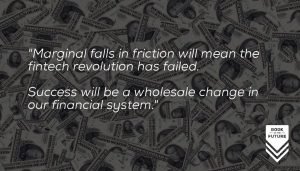Friction starts fires, but ambition changes worlds

A year ago this week I was delivering the keynote speech at the Future Money conference in London. Next week I will be delivering a talk at Fintech North as part of Leeds Digital Festival.
In between the two events my attitude to the coming transformations has become significantly more cautious. Not pessimistic, as suggested by F6S/tech.eu’s Jon Bradford, but concerned that the opportunity is so great that it cannot possibly be fulfilled.
The risk, and the fear, come from the fact that the opportunity is not purely commercial, it is social.
A year ago I spoke about the various frictions in the financial system that were the ignition points for new innovation: the speed and cost of moving money and taking payments; a lack of trust in the big banks. Today more friction points are being exposed and exploited all the time, driving the fintech boom.
But each new innovation seems to be an incremental improvement. A profitable sliver shaved off the giant banks, while the core remains unchanged. As Chris Gledhill, one of the other speakers at Future Money, put it when he left Lloyds to found Secco: “Even outside [the banks], the FinTech communities are innovating around existing financial protocols — making them cheaper, faster, better. They’re not trying to actually reinvent these things.”
What we have with the advent of technologies like the blockchain and its derivatives is an opportunity to reinvent the very structure of our financial system. The balance of power. The centralised nature. Not just to eliminate friction but to embed greater fairness.
This might sound like socialist moralising but really it should appeal to anyone of an entrepreneurial nature. By lowering friction but also redistributing power we can create a much more open marketplace. New platforms for innovation but also lower barriers to raising money, and collecting it from customers. Simpler access to new markets, nationally and internationally.
I am hugely hopeful that our financial system two decades from now looks radically different to how it does today. More open. More distributed. Lower cost and lower friction.
Will that come from individual innovations? Or does it require someone with a larger vision?
I’m not sure.
So I remain hopeful, but cautious.
